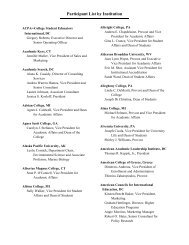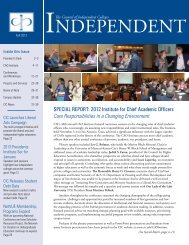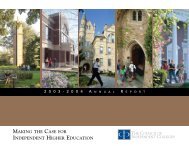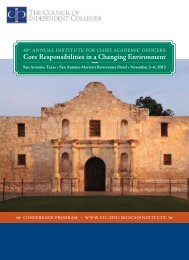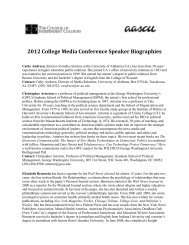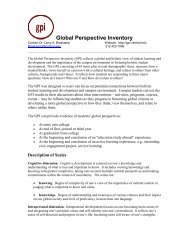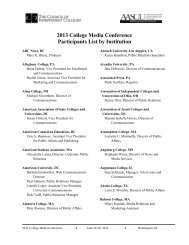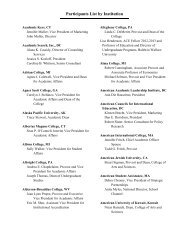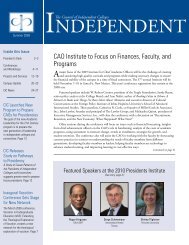Winter/Spring 2003 - The Council of Independent Colleges
Winter/Spring 2003 - The Council of Independent Colleges
Winter/Spring 2003 - The Council of Independent Colleges
- No tags were found...
Create successful ePaper yourself
Turn your PDF publications into a flip-book with our unique Google optimized e-Paper software.
PRESIDENTS INSTITUTE(Tuition Discounting, cont’d from page 8)the institution that was not succeedingin attracting teenagers from Chicago’s8.6 million population. Soon after hearrived, the college established a newapproach that guaranteed 40 percent <strong>of</strong>financial aid need from any and allsources to its traditional student registrants.“<strong>The</strong> plan has been working wellin attracting students,” Cain says. Inaddition, modifications to strategiesadopted at Judson at that time havesince decreased Judson’s net tuition discountfrom 41.35 percent to 33.69 percentin 2002. This reduction “opened a$1 million amount for spending onother college needs,” Cain noted.David Pollick, president <strong>of</strong> LebanonValley College (PA), identified a formerpresident, the late John Synodinos, asmastermind <strong>of</strong> the college’s recovery inthe 1990s when enrollment was lessthan half <strong>of</strong> the 1,550 it is today andwhen 90 percent <strong>of</strong> its students relied onfinancial aid. According to Pollick,Synodinos initiated a widely-publicizedstrategy in 1992 that promised a meritbasedscholarship <strong>of</strong> a 50 percent tuitiongrant to any applicant who graduated inthe top 10 percent <strong>of</strong> her or his highschool class, no questions asked. Thisled to a steady and consistent climb inenrollment at Lebanon Valley in thenumber <strong>of</strong> first-year students (from 288in 1992, to 412 in 1996), said Pollick,noting that SAT quality indicators alsohave grown from averages in the mid-900s to the 1100s.“We held our discount rate levelthroughout this period,” Pollick notes.“We also turned our early income gainsback immediately into the aesthetics <strong>of</strong>the physical plant. We wanted everyoneto see a competitive campus that wasworthy <strong>of</strong> our promises. We also paidclose attention to our net dollars.”Anne Steele, president <strong>of</strong>Muskingum College (OH), brought theparticipants up to date with what hastranspired since Muskingum cut $4,000from its tuition in the fall <strong>of</strong> 1996, wellbefore she arrived. “One <strong>of</strong> the primaryreasons we lowered tuition from $13,850to $9,850,” Steele says, “was to increasethe numbers in our applicant pool.”This action received widespread nationalpublicity and skeptics have sincequestioned whether the move wouldultimately improve or diminish thecharacter <strong>of</strong> the institution.Steele related that in 1996 Muskingumhad a stable enrollment <strong>of</strong>approximately 300 freshmen and adiscount rate <strong>of</strong> 31 percent. It enrolledabout 1,000 students, yet suffered fromexcess capacity while boasting a 12-toonestudent-to-faculty ratio and underusedresidences (only 68 percent <strong>of</strong> residenceshoused students). Shortage <strong>of</strong>revenue was also preventing longdelayedmaintenance. “<strong>The</strong> first fall, weincreased applications by 450 and ourfirst-year class enrollment by 100 students—withoutdiminishing our averageACT scores,” she said. “This ACT levelhas held steady—as has our discountrate <strong>of</strong> 31 percent.” Muskingum is nowin Phase II <strong>of</strong> its aggressive approach.This phase demands that the collegeupgrade its capacity to keep up withdemand. Steele explained particulars <strong>of</strong>the growing pains and how Muskingumhas confronted those needs. “We’re nowat 99 percent capacity, and this past yearwe also had our first waiting list <strong>of</strong>applicants in school history.” <strong>The</strong> onlydownside, she warns, is that studentretention levels are erratic. She blamesthe disruption <strong>of</strong> building new facilitiesas well as the growing population <strong>of</strong>Muskingum (enrollment is up to 1,610)for some changes that students dislike.Steele is quick to add, “It was not theprice reduction that brought Muskingummore students. It was the quality <strong>of</strong> thecollege that brought more students. Ourreducing <strong>of</strong> the price got more studentsto look at us.”Kurz concluded that these threedifferent approaches show the effectiveness<strong>of</strong> using pricing and student aidstrategically. (Moody, cont’d from page 8)Although institutions have little controlover the external factors that createthese economic challenges, Fitzgeraldsuggested that presidents could managetheir institutions so that the level <strong>of</strong> riskis reduced. One strategy is to achieve anappropriate balance between missiondrivenactivities that tend to increasefinancial risk, mission-driven activitiesthat have a positive impact on themargin, and other activities that have apositive impact on the margin, but areless closely connected to mission.Additionally, she and Fitzgerald indicatedthat institutions can improve theirratings by doing the following:• stratify pricing to capitalize on areas<strong>of</strong> strength;• expand the student market withoutabandoning the core constituency;• establish a fundraising contingencyplan;• manage expenses—for example,retirement benefits;• engage in realistic budget planningand modeling;• focus on investment allocation—findalternatives to equities; and• rethink capital spending plans byfocusing on functionality andflexibility in capital projects. Campus FacilitiesDevelopment RequiresPartnershipsPresidents who intend to develop campusfacilities should form partnershipswith financial and real estate firms, saidpresenters at a Presidents Institute sessionon what presidents need to know indeveloping campus facilities.F. Stuart Gulley, president <strong>of</strong>LaGrange College (GA), a UnitedMethodist institution that has experiencedsteady growth in recent years;Patrick Russell, senior vice president <strong>of</strong>(cont’d on next page)<strong>Independent</strong> 9 www.cic.edu<strong>Winter</strong>/<strong>Spring</strong> <strong>2003</strong>



